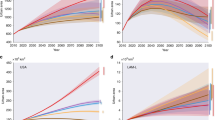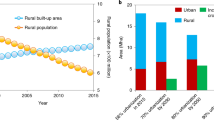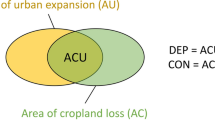Abstract
Henan, China, is likely the most populous agricultural province worldwide. It is China’s major grain-producing area, with a continuously increasing population (96 million), which is greater than 93% of countries worldwide. However, this province has been experiencing unprecedented urbanization recently due to national policies and measures, such as a plan to build the capital city of Henan into a national center, resulting in severe conflicts in land use that endanger food security regionally and globally. To facilitate decision-making on this problem, we explored the detailed urban-rural development of Henan by modeling these land-use conflicts. Conventional modeling of a region’s urban-rural development is to navigate trade-offs (a) solely between different land-use types (b) by assuming that each type provides a single service (e.g., croplands produce all the food), and (c) under a polynomial regression-based projection of population. In contrast, we considered both land-use type and intensity, resulting in a detailed land system for Henan. By introducing the concept of land system services (e.g., food production), we established a many-to-many relationship between land system classes and services. These allowed us to carry out the most comprehensive modeling of Henan’s urban-rural development under eighteen combined scenarios of population growth and land-use policies on food production. The modeling results of these scenarios provide a solid basis for making decisions regarding Henan’s urban-rural development. We also revealed the influence mechanism of population growth, land-use policies, and their combinations, highlighting the benefits of securing food production by agricultural intensification rather than merely expanding the area of cropland.
Similar content being viewed by others
References
Ahmed S J, Bramley G, Verburg P H, 2014. Key driving factors influencing urban growth: Spatial-statistical modelling with CLUE-S. Dhaka Megacity. Springer.
Bai Y, Wong C, Jiang B et al., 2018. Developing China’s Ecological Redline Policy using ecosystem services assessments for land use planning. Nature Communications, 9(1): 3034.
Bajracharya P, Lippitt C D, Sultana S, 2020. Modeling urban growth and land cover change in Albuquerque using SLEUTH. The Professional Geographer, 72(2): 181–193.
Chaudhuri G, Clarke K C, 2019. Modeling an Indian megalopolis: A case study on adapting SLEUTH urban growth model. Computers, Environment and Urban Systems, 77: 101358–101358.
Chen Y, Guo F, Wang J et al., 2020. Provincial and gridded population projection for China under shared socioeconomic pathways from 2010 to 2100. Scientific Data, 7(1): 1–13.
Cushman S A, 2015. Thermodynamics in landscape ecology: The importance of integrating measurement and modeling of landscape entropy. Landscape Ecology, 30(1): 7–10.
Cushman S A, 2016. Calculating the configurational entropy of a landscape mosaic. Landscape Ecology, 31(3): 481–489.
Dai K, Shen S, Cheng C et al., 2020. Trade-off relationship of arable and ecological land in urban growth when altering urban form: A case study of Shenzhen, China. Sustainability, 12(23): 10041.
Debonne N, van Vliet J, Heinimann A et al., 2018. Representing large-scale land acquisitions in land use change scenarios for the Lao PDR. Regional Environmental Change, 18(6): 1857–1869.
Debonne N, van Vliet J, Verburg P H, 2019. Future governance options for large-scale land acquisition in Cambodia: Impacts on tree cover and tiger landscapes. Environmental Science & Policy, 94: 9–19.
Delzeit R, Zabel F, Meyer C et al., 2017. Addressing future trade-offs between biodiversity and cropland expansion to improve food security. Regional Environmental Change, 17(5): 1429–1441.
Deng Y, Liu S, Cai J et al., 2015. Spatial pattern and its evolution of Chinese provincial population: Methods and empirical study. Journal of Geographical Sciences, 25(12): 1507–1520.
Dong N, You L, Cai W et al., 2018. Land use projections in China under global socioeconomic and emission scenarios: Utilizing a scenario-based land-use change assessment framework. Global Environmental Change, 50: 164–177.
Eitelberg D A, van Vliet J, Doelman J C et al., 2016. Demand for biodiversity protection and carbon storage as drivers of global land change scenarios. Global Environmental Change, 40: 101–111.
Ellis E C, Pascual U, Mertz O, 2019. Ecosystem services and nature’s contribution to people: Negotiating diverse values and trade-offs in land systems. Current Opinion in Environmental Sustainability, 38: 86–94.
Freire S, Doxsey-Whitfield E, MacManus K et al., 2016. Development of new open and free multi-temporal global population grids at 250 m resolution.
Gao L, Bryan B A, 2017. Finding pathways to national-scale land-sector sustainability. Nature, 544(7649): 217–222.
Gao P, Cushman S A, Liu G et al., 2019. FracL: A tool for characterizing the fractality of landscape gradients from a new perspective. ISPRS International Journal of Geo-Information, 8(10): 466.
Gao P, Li Z, 2019. Computation of the Boltzmann entropy of a landscape: A review and a generalization. Landscape Ecology, 34(9): 2183–2196.
Gao P, Li Z, Zhang H, 2018. Thermodynamics-based evaluation of various improved Shannon entropies for configurational information of gray-level images. Entropy, 20(1): 19.
Gao P, Wang H, Cushman S A et al., 2021a. Sustainable land-use optimization using NSGA-II: Theoretical and experimental comparisons of improved algorithms. Landscape Ecology, 36(7): 1877–1892.
Gao P, Zhang H, Li Z, 2017. A hierarchy-based solution to calculate the configurational entropy of landscape gradients. Landscape Ecology, 32(6): 1133–1146.
Gao P, Zhang H, Wu Z et al., 2021b. A joint landscape metric and error image approach to unsupervised band selection for hyperspectral image classification. IEEE Geoscience and Remote Sensing Letters: 1–5.
Gong P, Liu H, Zhang M et al., 2019. Stable classification with limited sample: Transferring a 30-m resolution sample set collected in 2015 to mapping 10-m resolution global land cover in 2017. Science Bulletin, 64(6): 370–373.
Gong P, Wang J, Yu L et al., 2013. Finer resolution observation and monitoring of global land cover: First mapping results with Landsat TM and ETM+ data. International Journal of Remote Sensing, 34(7): 2607–2654.
Government of Henan, 2017. Population Plan of Henan Province (2016–2030). Available from https://www.henan.gov.cn/2017/05-25/248952.html accessed.
Grundy M J, Bryan B A, Nolan M et al., 2016. Scenarios for Australian agricultural production and land use to 2050. Agricultural Systems, 142: 70–83.
He C, Li J, Zhang X et al., 2017. Will rapid urban expansion in the drylands of northern China continue: A scenario analysis based on the land use scenario dynamics-urban model and the shared socioeconomic pathways. Journal of Cleaner Production, 165: 57–69.
Henan Bureau of Statistics (HBS), 2018. Henan Statistical Yearbook. Beijing: China Statistics Press.
Hengl T, de Jesus J M, Heuvelink G B et al., 2017. SoilGrids250m: Global gridded soil information based on machine learning. PLoS One, 12(2): e0169748.
Jin G, Deng X, Zhao X et al., 2018. Spatiotemporal patterns in urbanization efficiency within the Yangtze River Economic Belt between 2005 and 2014. Journal of Geographical Sciences, 28(8): 1113–1126.
Jin G, Shi X, He D et al., 2020. Designing a spatial pattern to rebalance the orientation of development and protection in Wuhan. Journal of Geographical Sciences, 30(4): 569–582.
Kirch P V, Hartshorn A S, Chadwick O A et al., 2004. Environment, agriculture, and settlement patterns in a marginal Polynesian landscape. Proceedings of the National Academy of Sciences, 101(26): 9936–9941.
Kuang W, 2019. Mapping global impervious surface area and green space within urban environments. Science China Earth Sciences, 62(10): 1591–1606.
Kuang W, Dou Y, 2020. Investigating the patterns and dynamics of urban green space in China’s 70 major cities using satellite remote sensing. Remote Sensing, 12(12): 1929.
Lan T, Li Z, Ti P, 2019. Integrating general principles into mixed-integer programming to optimize schematic network maps. International Journal of Geographical Information Science, 33(11): 2305–2333.
Li X, Chen G, Liu X et al., 2017. A new global land-use and land-cover change product at a 1-km resolution for 2010 to 2100 based on human-environment interactions. Annals of the American Association of Geographers, 107(5): 1040–1059.
Li X, Chen Y, 2020. Projecting the future impacts of China’s cropland balance policy on ecosystem services under the shared socioeconomic pathways. Journal of Cleaner Production, 250: 119489.
Liao W, Liu X, Xu X et al., 2020. Projections of land use changes under the plant functional type classification in different SSP-RCP scenarios in China. Science Bulletin, 65(22): 1935–1947.
Liu X, Liang X, Li X et al., 2017. A future land use simulation model (FLUS) for simulating multiple land use scenarios by coupling human and natural effects. Landscape and Urban Planning, 168: 94–116.
Liu Y, Wang J, Long H, 2010. Analysis of arable land loss and its impact on rural sustainability in Southern Jiangsu Province of China. Journal of Environmental Management, 91(3): 646–653.
Long H, Liu Y, Wu X et al., 2009. Spatio-temporal dynamic patterns of farmland and rural settlements in Su-Xi-Chang region: Implications for building a new countryside in coastal China. Land Use Policy, 26(2): 322–333.
Lu Y, Chen B, 2017. Urban ecological footprint prediction based on the Markov chain. Journal of Cleaner Production, 163: 146–153.
Ma Y, Cheng J, Jiao F et al., 2008. Distribution, sources, and potential risk of polycyclic aromatic hydrocarbons (PAHs) in drinking water resources from Henan Province in middle of China. Environmental Monitoring and Assessment, 146(1–3): 127–138.
McGarigal K, Cushman S A, 2005. The gradient concept of landscape structure. In: Wiens J A, Moss M R (eds). Issues and Perspectives in Landscape Ecology. Cambridge: Cambridge University Press.
National Bureau of Statistics of China (NBSC), 2019a. Announcement of Statistics on Grain Production. Available from http://www.stats.gov.cn/tjsj/zxfb/201912/t20191206_1715827.html accessed 15 Oct. 2021.
National Bureau of Statistics of China (NBSC), 2019b. China Statistical Yearbook. Beijing: China Statistics Press.
O’Neill B C, Kriegler E, Riahi K et al., 2014. A new scenario framework for climate change research: The concept of shared socioeconomic pathways. Climatic Change, 122(3): 387–400.
Peng J, Hu X, Wang X et al., 2019a. Simulating the impact of Grain-for-Green Programme on ecosystem services trade-offs in northwestern Yunnan, China. Ecosystem Services, 39: 100998.
Peng J, Liu Q, Blaschke T et al., 2020. Integrating land development size, pattern, and density to identify urban-rural fringe in a metropolitan region. Landscape Ecology, 35(9): 2045–2059.
Peng J, Wang A, Luo L et al., 2019b. Spatial identification of conservation priority areas for urban ecological land: An approach based on water ecosystem services. Land Degradation & Development, 30(6): 683–694.
Peng S, Ding Y, Liu W et al., 2019c. 1 km monthly temperature and precipitation dataset for China from 1901 to 2017. Earth System Science Data, 11(4).
Pesaresi M, Huadong G, Blaes X et al., 2013. A global human settlement layer from optical HR/VHR RS data: Concept and first results. IEEE Journal of Selected Topics in Applied Earth Observations and Remote Sensing, 6(5): 2102–2131.
Pouzols F M, Toivonen T, Di Minin E et al., 2014. Global protected area expansion is compromised by projected land-use and parochialism. Nature, 516(7531): 383–386.
Riahi K, Van Vuuren D P, Kriegler E et al., 2017. The shared socioeconomic pathways and their energy, land use, and greenhouse gas emissions implications: An overview. Global Environmental Change, 42: 153–168.
Sahoo S, Sil I, Dhar A et al., 2018. Future scenarios of land-use suitability modeling for agricultural sustainability in a river basin. Journal of Cleaner Production, 205: 313–328.
Shaker R R, Altman Y, Deng C et al., 2019. Investigating urban heat island through spatial analysis of New York City streetscapes. Journal of Cleaner Production, 233: 972–992.
Sun X, Lu Z, Li F et al., 2018. Analyzing spatio-temporal changes and trade-offs to support the supply of multiple ecosystem services in Beijing, China. Ecological Indicators, 94: 117–129.
Talukdar S, Pal S, 2020. Modeling flood plain wetland transformation in consequences of flow alteration in Punarbhaba River in India and Bangladesh. Journal of Cleaner Production, 261: 120767.
Tang S, Zhang L, Hao Y et al., 2021. System dynamics modeling for construction material flows of urban residential building: A case study of Beijing, China. Resources, Conservation and Recycling, 168: 105298.
van Vliet J, Eitelberg D A, Verburg P H, 2017. A global analysis of land take in cropland areas and production displacement from urbanization. Global Environmental Change, 43: 107–115.
van Vliet J, Verburg P H, 2018. A short presentation of CLUMondo. In: Camacho Olmedo M T, Paegelow M, Mas J-F et al. eds. Geomatic Approaches for Modeling Land Change Scenarios. Springer International Publishing, Cham.
Vasenev V I, Stoorvogel J J, Leemans R et al., 2018. Projection of urban expansion and related changes in soil carbon stocks in the Moscow Region. Journal of Cleaner Production, 170: 902–914.
Verburg P H, Soepboer W, Veldkamp A et al., 2002. Modeling the spatial dynamics of regional land use: The CLUE-S model. Environmental Management, 30(3): 391–405.
Wallace K J, 2007. Classification of ecosystem services: Problems and solutions. Biological Conservation, 139(3/4): 235–246.
Wang T, Kazak J, Han Q et al., 2019a. A framework for path-dependent industrial land transition analysis using vector data. European Planning Studies, 27(7): 1391–1412.
Wang Y, van Vliet J, Pu L et al., 2019b. Modeling different urban change trajectories and their trade-offs with food production in Jiangsu Province, China. Computers, Environment and Urban Systems, 77: 101355.
Weiss D J, Nelson A, Gibson H S et al., 2018. A global map of travel time to cities to assess inequalities in accessibility in 2015. Nature, 553(7688): 333–336.
Wolff S, Schrammeijer E A, Schulp C J et al., 2018. Meeting global land restoration and protection targets: What would the world look like in 2050? Global Environmental Change, 52: 259–272.
Ye S, Song C, Shen S et al., 2020. Spatial pattern of arable land-use intensity in China. Land Use Policy, 99: 104845.
Zhang H, Wu Z, Lan T et al., 2020. Calculating the Wasserstein metric-based Boltzmann entropy of a landscape mosaic. Entropy, 22(4): 381.
Zhu W, Zhang J, Cui Y et al., 2020. Ecosystem carbon storage under different scenarios of land use change in Qihe catchment, China. Journal of Geographical Sciences, 30(9): 1507–1522.
Zou L, Liu Y, Wang J et al., 2019. Land use conflict identification and sustainable development scenario simulation on China’s southeast coast. Journal of Cleaner Production, 238: 117899.
Author information
Authors and Affiliations
Corresponding author
Additional information
Foundation: Strategic Priority Research Program of the Chinese Academy of Sciences, No.XDA23100303; National Natural Science Foundation of China, No.42271418, No.42171250, No.42230106; State Key Laboratory of Earth Surface Processes and Resource Ecology, No. 2022-ZD-04
Author: Gao Peichao (1991-), Assistant Professor, specialized in information geography.
Electronic supplementary material
Rights and permissions
About this article
Cite this article
Gao, P., Xie, Y., Song, C. et al. Exploring detailed urban-rural development under intersecting population growth and food production scenarios: Trajectories for China’s most populous agricultural province to 2030. J. Geogr. Sci. 33, 222–244 (2023). https://doi.org/10.1007/s11442-023-2080-3
Received:
Accepted:
Published:
Issue Date:
DOI: https://doi.org/10.1007/s11442-023-2080-3




